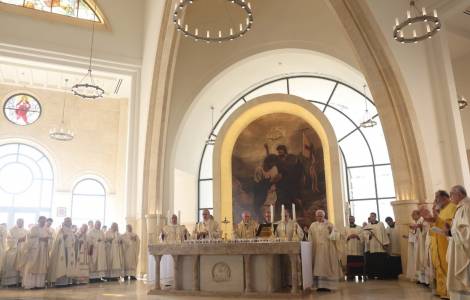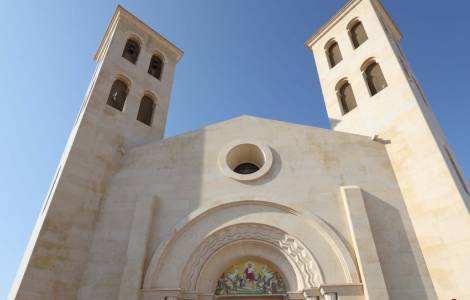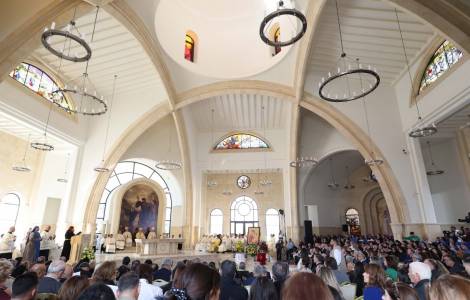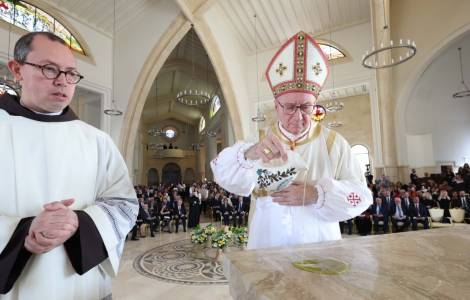
Patriarcato Latino di Gerusalemme
Wadi Kharar (Agenzia Fides) - It is intended to be a place of prayer, celebration and reflection, but also a place of rest for the many pilgrims who visit the conflict-torn Holy Land: after the solemn inauguration ceremony of the new church, at the place where Jesus was baptized, the "contemplative missionaries" of the Institute of the Incarnate Word on the banks of the Jordan River are now preparing for a new life. Until recently, there was no such structure here. Work only began in 2009.
The solemn inauguration of the altar by Cardinal Secretary of State Pietro Parolin, on January 10, in which many people participated, was experienced as "a special moment of grace". "We continue to thank the Lord for the magnificent ceremony we experienced," Father Sergio Perez, priest of the Institute of the Incarnate Word, which is entrusted with the care of this shrine, told Fides.
"For us it is a great honor and a great responsibility," adds Father Perez, then recounting the long story from the laying of the foundation stone to the inauguration, which lasted a good 15 years: "This project was entrusted to us in 2008, when the Latin Patriarch of Jerusalem was still Fouad Twal. At that time there was nothing. The following year, 2009, Benedict XVI came during his trip to the Holy Land to bless the foundation stone of the Shrine. At the end of 2024, 15 years later, the work was completed. The stone altar, the ambo and the beautiful image of the Baptism of Jesus that adorns the apse were still missing. The final work was completed the day before the great feast."
And now "the Latin Patriarchate of Jerusalem and the Church in Jordan have also entrusted our religious family with the care of pilgrims," stresses Father Perez, pointing out that there are currently two contemplative communities on site: five priests (a sixth will arrive in the coming months) who live as monks, and six sisters from the same religious family, for a total of 12 consecrated persons.
"We practice the monastic life, we sing the Liturgy of the Hours, we celebrate Mass together with the sisters. And then the silence, the work, the study, the Lectio Divina and the evening recreation," says the missionary. The place, which also includes a guest house, is ready to "welcome pilgrims." Pilgrims who, according to Father Perez, "have always been here. Before the war, many people came to this shore. Now Jordan is full of refugees from Syria and Palestine, but there is no lack of pilgrims, even if their numbers are decreasing."
The flow of pilgrims began when archaeologist Michele Piccirillo, a Franciscan friar who died in 2008, found the remains of some tubs here and identified the place as the "Bethany beyond the Jordan" mentioned in the Gospel of John. According to Piccirillo's research, ancient churches built by the young Christian communities stood here, which identifies the place as the place where Jesus was baptized.
With the support that "King Abdullah II gives to the Church and its works" (the king has for some time donated land to all the Christian denominations living in Jordan, allowing each of them to build a place of worship on the banks of the river, ed.), structures have been built to accommodate "those who come to the monastery for spiritual retreats, but also groups who come with guides to visit various Holy Places".
After all, this has always been a crossroads of peoples and nations, a true "place of passage", as Father Perez explains: "On these shores the passage of Joshua with the Ark of the Covenant took place, as described in the Bible, the passage from the Old to the New Testament, the passage from the hidden life to the public life of Jesus and, with baptism, the passage from death to eternal life". And if you look up, you can see that you are surrounded by places where the human and the divine have touched each other. Very close by is also the hill where, according to tradition, the prophet Elijah was taken to heaven in a chariot of fire. A few dozen kilometers away is the fortress of Herod at Machaerus (Macheronte), where John the Baptist was martyred by beheading, and Mount Nebo, where the earthly journey of Moses also ended.
Father Perez hopes that this place "will increasingly become a place of encounter between people and between people and God, as well as a place of transition. Here everything reminds us that each of us is on a journey and our final destination is eternal life." (F.B.) (Agenzia Fides, 14/1/2024)

Patriarcato Latino di Gerusalemme

Patriarcato Latino di Gerusalemme

Patriarcato Latino di Gerusalemme